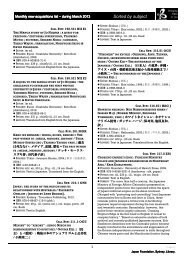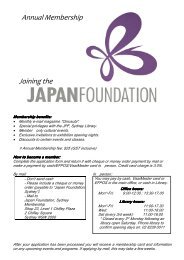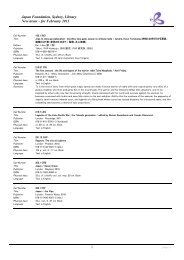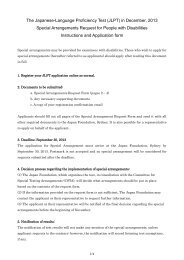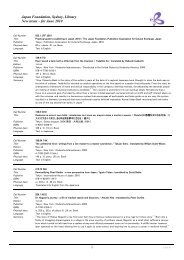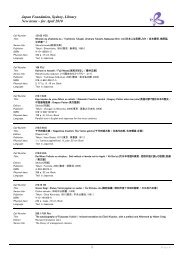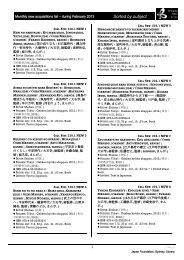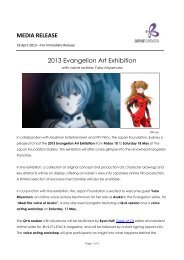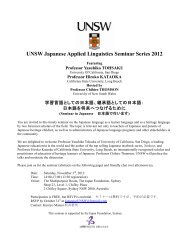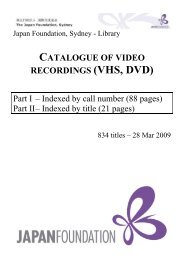catalogue of video recordings (vhs, dvd) - The Japan Foundation
catalogue of video recordings (vhs, dvd) - The Japan Foundation
catalogue of video recordings (vhs, dvd) - The Japan Foundation
Create successful ePaper yourself
Turn your PDF publications into a flip-book with our unique Google optimized e-Paper software.
<strong>Japan</strong> <strong>Foundation</strong>, Sydney, Library<br />
Video <strong>catalogue</strong> (VHS, DVD) – Indexed by call number<br />
System requirements:DVD (Region ALL).<br />
Language: Soundtrack in English.<br />
Summary: Zen Buddhism, introduced into <strong>Japan</strong> from China in the<br />
latter part <strong>of</strong> the twelfth century, has been and continues to be a<br />
central creative force in <strong>Japan</strong>ese culture since the fourteenth<br />
century. This <strong>video</strong>gram presents the living reality <strong>of</strong> Zen today, forst<br />
through the strict daily routine in the training hall <strong>of</strong> a large Zen<br />
monastery. Focus is the shifted to a variety <strong>of</strong> traditional arts in spired<br />
by Zen calligraphy, ink painting, dry landscape gardens, noh, and the<br />
tea ceremony, revealig the austerity and incisive simplicity that are<br />
their distinctive characteristics. Underlying both Zne practice and the<br />
culture it gave rise to in <strong>Japan</strong> is the attempt to penetrate all that is<br />
inessential and awaken to the true reality. It is this attempt that forms<br />
the central theme <strong>of</strong> Zen culture, Zen spirit.<br />
Restriction & Screening notes: Licensed for public screening at JF-<br />
Sydney.<br />
Call Number: 210.12 JPF<br />
Title: On a Wind From the South<br />
Publisher: 1982<br />
Physical description: 29 min Video Recording<br />
System requirements: VHS [PAL]<br />
Language: Soundtrack in English.<br />
Summary: This documentary begins in August 1543 when the very first<br />
foreigners were washed up on <strong>Japan</strong>ese shores. This started a<br />
continuous facination with the western and its culture. <strong>The</strong> Portuguese<br />
brought their religion with them and Christianity steadily took hold <strong>of</strong><br />
<strong>Japan</strong>. <strong>The</strong> <strong>Japan</strong>ese also developed a love <strong>of</strong> guns and this in turn<br />
changed the architecture <strong>of</strong> the <strong>Japan</strong>ese castles forever. Trade with<br />
the outside world continued , to the delight <strong>of</strong> many <strong>Japan</strong>ese<br />
collectors, until the early 17th century when foreign religion and<br />
culture was banned in <strong>Japan</strong> for 250 years.<br />
Call Number: 210.25 NHK 1<br />
Title: Hajimeni katachi ariki = Form at the beginning | [produced by<br />
NHK International].|はじめに 形 ありき = Form at the beginning |<br />
[produced by NHK International].|<br />
Publisher: [Tokyo?] : NHK International, [200-?].<br />
Physical description: 1 <strong>video</strong>disc (DVD) (45 min.) :sd., col. ;4 3/4 in.<br />
Video Recording<br />
System requirements:DVD (NTSC).<br />
Language: Soundtrack in <strong>Japan</strong>ese with English subtitles.<br />
Summary: "Jōmon ceramics are the world's oldest examples <strong>of</strong> pottery.<br />
<strong>The</strong>ir bold, mystical forms are compelling even to the modern eye. But<br />
where did these forms come from? No one knows. Critic Shūichi Kato's<br />
search for clues leads him to the distant Mayan culture <strong>of</strong> Mexico. He<br />
compares Jōmon culture with Mayan civilization." -- from 300 TV<br />
PROGRAMMES ON JAPAN.<br />
Restriction & Screening notes: Not for loan. Licensed for public<br />
screening at JF-Sydney<br />
Call Number: 210.3 JPF<br />
Title: From the Asian Continent : Chinese characters and Buddhism<br />
in <strong>Japan</strong> = [Tairiku bunka no sesshu : Kanji to Bukkyō no denrai].|From<br />
the Asian Continent : Chinese characters and Buddhism in <strong>Japan</strong> =<br />
[ 大 陸 文 化 の 摂 取 : 漢 字 と 仏 教 の 伝 来 ]|<br />
Publisher: c1983 (Tokyo : <strong>Japan</strong> <strong>Foundation</strong>, 2007)<br />
Physical description: 1 <strong>video</strong>disc (DVD) (ca. 30 min.) :sd., col. ;4 3/4 in.<br />
Video Recording<br />
System requirements:DVD (Region ALL).<br />
Language: Soundtrack in English.<br />
Summary: This <strong>video</strong>gram introduces the characteristics <strong>of</strong> <strong>Japan</strong>ese<br />
culture throught the ways in which the <strong>Japan</strong>ese people adopted and<br />
absorbed elements <strong>of</strong> culture from the Asian Continent as they were<br />
introduced via the Korean Peninsula from the 4th to the 6th century.<br />
<strong>The</strong> <strong>video</strong>gram focuses especially on the introduction <strong>of</strong> Chinese<br />
characters (Kanji) and Buddhism. <strong>The</strong> <strong>Japan</strong>ese simplified the Chinese<br />
system <strong>of</strong> writing and created their own syllabaries called hiragana and<br />
katakana that contributed to the development <strong>of</strong> <strong>Japan</strong>'s unique<br />
literature, education, culture and society, and in turn its politics and<br />
economy. Buddhism also went through various changes and deeply<br />
influenced <strong>Japan</strong>ese thought, painting, sculpture and architecture.<br />
Restriction & Screening notes: Licensed for public screening at JF-<br />
Sydney.<br />
Call Number: 210.5 EMP<br />
Title: <strong>Japan</strong>, memoirs <strong>of</strong> a secret empire = Monon<strong>of</strong>utachi no kioku |<br />
produced & directed by Lyn Goldfarb, Deborah Ann DeSnoo.<br />
Series title: Empires (Television program)<br />
Publisher: [Collingwood, Vic.] : Madman Entertainment, [2007], c2003.<br />
Physical description: 1 <strong>video</strong>disc (DVD) (165 min.) :sd., col. ;4 3/4 in.<br />
Video Recording<br />
System requirements:DVD-9 (Region 4, PAL); dual layer; anamorphic<br />
widescreen (16:9) presentation; English soundtrack in 2.0 Dolby Digital<br />
Language: Soundtrack in English with English subtitles for the hearing<br />
impaired.<br />
Rating: OFLC rating: E (exempt from classification).<br />
Summary: Commanding shoguns and samurai warriors, exotic geisha<br />
and exquisite artisans - all were part <strong>of</strong> the <strong>Japan</strong>ese "renaissance" -<br />
a period between the 16th and 19th Centuries when <strong>Japan</strong> went from<br />
chaos and violence to a land <strong>of</strong> ritual refinement and peace. But<br />
stability came at a price: for nearly 250 years, <strong>Japan</strong> was a land closed<br />
to the Western world, ruled by the Shogun under his absolute power<br />
and control. <strong>Japan</strong> brings to life the unknown story <strong>of</strong> a mysterious<br />
empire.<br />
Call Number: 210.58 MID<br />
Title: <strong>Japan</strong> : <strong>The</strong> Changing Tradition - Revere the Emperor, Expel the<br />
Barbarian<br />
Publisher: 1987<br />
Physical description: 29 min Video Recording<br />
System requirements:VHS (NTSC).<br />
Language: Soundtrack in English.<br />
Summary: This history documentary covers the period from 1853 to<br />
the emergence <strong>of</strong> the Meiji Era. It contains re-enactments <strong>of</strong> import<br />
moments in <strong>Japan</strong>s political history <strong>of</strong> un-rest. <strong>Japan</strong> was confronted<br />
by America in 1853 to open its ports for international trade; this<br />
started a 15 year struggle over the rule <strong>of</strong> <strong>Japan</strong>.<br />
Call Number: 210.6 MID<br />
Title: <strong>Japan</strong> : <strong>The</strong> Changing Tradition - ""Rich Country, Strong<br />
Military""<br />
Publisher: Lincoln, NE : GPN 1987<br />
Physical description: 29 min Video Recording<br />
System requirements:VHS (NTSC).<br />
Language: Soundtrack in English.<br />
Summary: By 1910 <strong>Japan</strong> was a modern country, that had won two<br />
Wars, was respected by the west and whose economy was booming.<br />
This documentary discusses how <strong>Japan</strong> got to this position in History,<br />
starting from 1868 when Meiji leaders began to take power. This was a<br />
period <strong>of</strong> rapid change for <strong>Japan</strong>, there were uprising from the Samurai<br />
classes against the new political regime and international relations<br />
2 21-Apr-10



